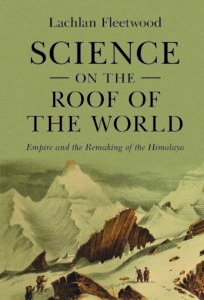This post marks the first in the series of our ‘mountain research spotlights’ series, sharing the work and insights of colleagues working on mountains across the humanities (and beyond).
 Name and institution: Lachlan Fleetwood, LMU Munich
Name and institution: Lachlan Fleetwood, LMU Munich
Research summary: My first book is a history of science and empire in the Himalaya, and shows how altitude – and altitude above sea level in particular – became the category that made some mountains matter more than other in the early nineteenth century. This valorisation of altitude is something that echoes down to the present, perhaps most explicitly embodied by the annual queues that form on Everest. My research tells the story of the imaginative, scientific and political shifts that brought this about, and aims to demonstrate how mountains can serve as scales for new histories of science, empire and environment.
Do you define yourself as working within the mountain humanities / mountain studies?
I am perhaps most explicitly a historian/historian of science with interests in empire, geography and environment, though I also have a strong affinity with the work of historical geographers and South Asianists. I have worked closely on mountains (especially the Himalaya) and certainly see myself as engaging with mountain studies writ large (including work by literary scholars and anthropologists). Of course, as my PhD supervisor would not infrequently ask – what, if anything, is distinctive about mountain as spaces for questions of empire, science, labour etc. This is something I still grapple with, and a question which I hope the ‘Mountain Humanities’ can address.
More recently I’ve been drawn – as I think many of us have – to the umbrella of ‘Environmental Humanities,’ of which the Mountain Humanities must I think be a part. This provides opportunities not only for engagement across disciplines in the humanities (for example between history and literature) but also with natural scientists, as seems essential in addressing pressing Anthropocene questions and consequences, many of which are particularly visible in mountain spaces.
I should also say that I am interested in not only mountains but also other geographical spaces that are often seen as ‘extreme,’ or as aberrations from lowland or temperate/European norms. Indeed, my current project is a history of climatic sciences and environmental determinism in the mountains – but also especially the deserts – of Central Asia. The research is as much about arid as upland regions/mountains, though I trace the similarities in terms of imperial imaginative geographies (i.e. around the limits of habitability) and also have the direct relationships between uplands and lowlands in mind.
 Tell us more about your latest book?
Tell us more about your latest book?
“When, how, and why did the Himalaya become the highest mountains in the world? In 1800, Chimborazo in South America was believed to be the world’s highest mountain, only succeeded by Mount Everest in 1856. Science on the Roof of the World tells the story of this shift, and the scientific, imaginative, and political remaking needed to fit the Himalaya into a new global scientific and environmental order. This book traces untold stories of scientific measurement and collecting, indigenous labour and expertise, and frontier-making to provide the first comprehensive account of the East India Company’s imperial entanglements with the Himalaya. To make the Himalaya knowable and globally comparable, I demonstrate that it was necessary to erase both dependence on indigenous networks and scientific uncertainties, offering an innovative way of understanding science’s global history, and showing how geographical features like mountains can serve as scales for new histories of empire.”
The book was published by Cambridge University Press in 2022, and I’ve also recently published a short essay, ‘Why does Everest matter?’ which summarises some of my recent thinking on mountains.
